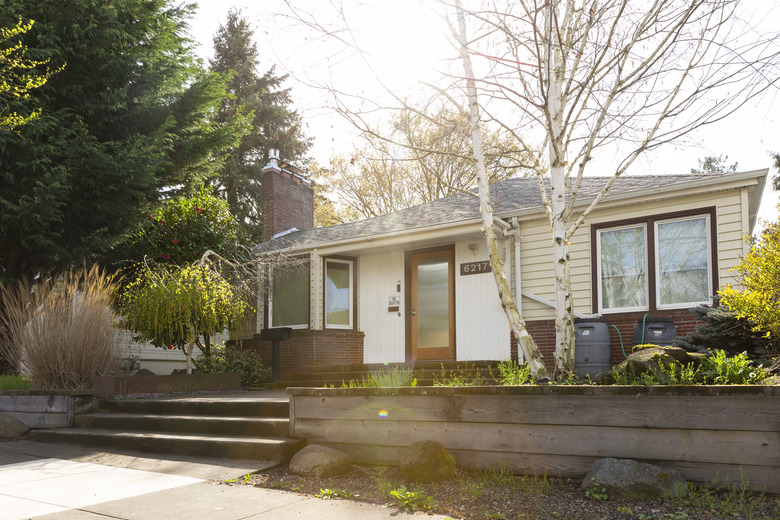How To Remove A Tree Safely: A DIY Guide
We may receive a commission on purchases made from links.
Tree removal can be scary business. Trees are heavy and fall in unpredictable ways, and you could get injured, or your property could be damaged even if you know all the proper procedures and follow them carefully.
Do you have a redwood or Douglas fir that needs to come down? You wouldn't even think of attempting to do this job yourself, but what about an old cherry tree that's struggling to survive and is blocking your view of the garden? Depending on the size of the tree, removal may be a DIY option, but it hinges on several factors. Also, don't forget that once the tree is down, you still have to get the stump out, and no, that's not a job for your old pickup — at least not until you prepare the stump.
The Dangers of Tree Removal
The Dangers of Tree Removal
It's you and a chain saw — what could possibly go wrong? A lot. An 80-foot maple tree can weigh as much as 10 tons, and even though a tree of that size would call for professional tree removal, a tree that you could cut down yourself could easily weigh half as much. That's too heavy for your pickup to tow away once it's down, and it would give you a serious headache if it fell on you.
Even if you're careful, any one of the following accidents could occur:
- A branch could fall on a nearby building and cause structural or roof damage.
- The tree could be heavier on one side than the other and could fall in an unexpected direction.
- The base of the trunk could suddenly break loose of the stump and snap back toward you.
- Instead of falling to the ground, the tree could get caught on other nearby trees or on power lines.
Tree removal service pros know how to avoid such problems, and more importantly, they have the equipment to do it. However, the risks go down considerably when you're removing a very small tree (one you can trim or cut down without using a ladder). You might need a pole saw or loppers to cut the top branches, and the trunk may be thick enough to require a chain saw, but you can do everything while standing on solid ground so you can get away quickly if something does go amiss.
How to Minimize the Hazards of Tree Removal
How to Minimize the Hazards of Tree Removal
Follow these five safety rules when cutting down a tree yourself:
- Wear personal protection, including protection for your head, goggles, and ears as well as leather boots that protect your ankles and chaps to protect your legs.
- Make sure your chain saw is in good working order, including the chain brake and the spark arrestor, and make sure it has a sharp chain.
- Carefully examine your surroundings, paying attention to nearby trees, overhead power wires, and anything that might be damaged if the tree falls on it.
- Make a plan for how you want the tree to fall. Prepare at least two escape routes that aren't in the projected path of the falling tree.
- Plan removal of the stump. While you can often cut the root system of small ones and pull them out of the ground, you may have to resort to stump grinding or chemicals, such as potassium nitrate, for large ones.
Never use a chain saw while on a ladder and do not raise the saw above your shoulders when cutting. One unexpected movement of the tree can send you tumbling to the ground with a working chain saw in your hand. One more safety note is to be even more careful when cutting down a dead tree because old wood breaks easily, and branches can snap off before you've finished cutting them.
How to Cut Down a Tree
How to Cut Down a Tree
If the tree you want to remove is leaning, assume it's going to fall in the direction of the lean. If the ground is clear in that direction and no obstacles will prevent the tree from falling, you're good to go. If you need the tree to fall in a direction other than the one it's leaning, call a professional tree service. If the tree is growing straight, you should be able to control the direction of its fall.
Warning
Only cut down a tree that can easily be trimmed and cut without the use of a ladder. Anything else needs to be handled by a professional tree removal service.
1. Trim as Many Branches as Possible
Use loppers or a tree-pruning saw to cut off as many branches as you can since the fewer branches there are, the less clearance the tree will need when it falls. You can also do this job with a pole saw, which is a small gasoline- or battery-powered chain saw on the end of a telescoping pole. It makes the job faster and allows you to cut bigger branches with ease.
Cut branches as close to the trunk as possible, but even if you have to cut some of them farther out, each one you cut will make the tree more manageable. Keep the tree balanced by cutting equally from all sides, or it may be too heavy on one side, which would cause it to fall in a different direction than the one you expect.
2. Clear Your Escape Route
Remove all obstacles from your escape route that may slow you down or cause you to trip. Remember that it's best to have more than one escape route.
3. Notch the Trunk
Using a chain saw for trunks larger than 3 or 4 inches in diameter and a reciprocating saw (fitted with a pruning blade) for thinner ones, cut a notch on the side of the trunk toward which you want the tree to fall. Start the notch by cutting diagonally downward into the trunk at a 60-degree angle at a point on the trunk just above where it widens to form the root system, which is usually 1 to 2 feet above the ground. Finish the notch by making a horizontal undercut into the trunk below the angled one until the two cuts meet, which should be about 25 percent of the way through the trunk, and remove the cutout.
4. Make a Felling Cut
Make a horizontal cut on the opposite side of the trunk a few inches above the undercut. Stop cutting a few inches before the notch, leaving a hinge holding the trunk to the stump that is about 10 percent of the diameter of the trunk. Do not cut all the way through to the notch or you won't have any control over the direction the tree falls.
5. Use a Wedge to Make the Tree Fall
Drive a felling wedge into the felling cut using a sledgehammer and gradually widen the gap until the tree falls toward the notch. Be sure to warn everyone in the area before you start pounding and move away from the tree as soon as it starts falling. Move away in a 90-degree direction. Do not move in the direction of the wedge in case the hinge snaps and the tree falls off the stump.
Disposing of the Trunk
Disposing of the Trunk
Once the tree is safely on the ground, you'll have to cut it into pieces to remove it or keep it for firewood, and you can do this with a chain saw. Start by cutting off all the branches that you couldn't remove before and haul them away. Then, cut the trunk into manageable lengths. Be careful of "kissing the earth" with the chain saw (letting the chain touch the ground) to avoid dulling the chain and having to resharpen it before you're done with the tree. A good technique to avoid doing this is to keep the chain angled slightly upward as you cut.
Removing the Stump Without Digging
Removing the Stump Without Digging
Depending on the size of the tree, you may be able to dig up the stump and lever it out of the ground with a digging bar, but if the trunk is larger than about 10 inches in diameter, stump grinding or chemical treatment may be preferable. If you opt for stump grinding, you'll probably want to call a pro because stump grinders are large, powerful machines, and the cost to rent one to remove a single stump is not much less than the cost of professional removal.
If you're not in a hurry to remove the stump, tree stump removal chemicals can do the job effectively, but it takes several weeks for the stump to rot sufficiently for you to dig it out. Drill several 1-inch holes in the top of the stump and 45-degree holes in the side to meet the ones drilled in the top, pour in the chemical (which comes in granular form), and fill the holes with water to allow the chemicals to soak in. After four to six weeks, the stump should have rotted sufficiently to allow you to break it up with an axe. Covering the stump with mulch and a tarp makes it decompose more quickly, and it keeps children and animals away from it.
Check the container of the stump remover to make sure the chemicals are safe to use and won't harm any plants surrounding the tree. The active ingredient in most granular products is either potassium nitrate or sodium metabisulfite, which are both decomposing agents and won't affect surrounding vegetation. Some liquids designed to be applied with a paintbrush contain a herbicide to kill the stump, such as triclopyr, which shouldn't get into the surrounding soil.
How to Dig Out the Stump
How to Dig Out the Stump
If the stump isn't very big, digging it up shouldn't present many difficulties, particularly if you water the ground thoroughly the day before you dig to soften the soil. As a rule, you'll have to dig 6 inches into the soil for every inch of diameter of the trunk to reach the bottom of the tap root and to the outer edge of the tree's canopy to uncover the root ball. Once the tree roots are uncovered, work a digging bar under the root ball and wiggle the stump until you can gradually lift it out of the ground.
If you're removing the stump of a fairly large tree, you may not want to do all that digging. In that case, confine your efforts to the area around the taproot, and as you uncover lateral roots, cut them with a reciprocating saw or an axe. Don't use a chain saw for this or the chain won't last very long.
Keep digging and cutting until you've uncovered most of the taproot and then work the stump out with a digging bar. At this point, you have an opportunity to show off the power of your pickup because if you wrap a chain around what's left of the stump and attach the chain to your truck, it should be able to pull the stump — minus its roots — out of the ground.


